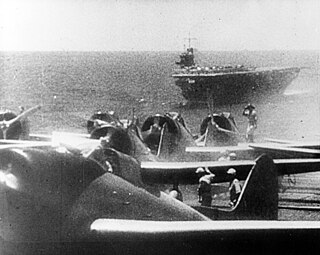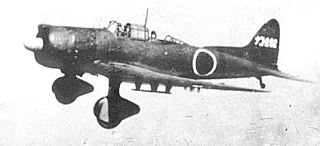Design and development
In 1931, the Japanese Navy placed an order with the Heinkel aircraft company for a two-seat dive bomber, capable of carrying 250 kg (550 lb) of bombs, stressed for catapult launches, and capable of using either wheeled or float undercarriages. [1] [2]
A prototype, the Heinkel He 50aW, was completed in the summer of 1931. It was a biplane of mixed construction. The aircraft had twin floats and was powered by a Junkers L5 inline engine. The engine was found to be underpowered. [2] A second prototype, the He 50aL, was built, powered by a Siemens Jupiter VI radial engine, having a wheeled undercarriage. A second He 50aL was built and redesignated He 50b. [2] Based on the He 50b, a third prototype designated Heinkel He 66 was completed for the Japanese Navy, and used as the basis of the Aichi D1A. [3]
The He 50 was an equal-span biplane based on a rectangular-section fuselage with a primary structure of welded steel tube construction, faired out to an oval shape by wooden formers and stringers and covered with fabric except in the extreme nose, which was skinned in light alloy. [2] The wings were of fabric-covered wooden construction with a marginal stagger and very slight sweep, carrying ailerons on all four panels. [3]
Operational history
The He 50aL was redesignated He 50 V1 and demonstrated to the German Defence Ministry in 1932. This resulted in an order for three development aircraft, and a production batch of 60 He 50A-1 aircraft, which were built during the summer of 1933. The Republic of China placed an order for 12 He 50As, but modified with an engine cowling added and designated He 66b. These aircraft were commandeered by the Luftwaffe and redesignated He 50B. In 1935, the He 50 was delivered to the Luftwaffe's first dive bomber unit, and later partially equipped nine other dive bombing units. The He 50, however, was steadily replaced by the Henschel Hs 123 and Junkers Ju 87, after which He 50s were transferred to dive bomber training units. [2]
In spring 1943, following the success of the Soviet VVS's Night Witches units against the Wehrmacht Heer's frontline encampments while flying their Polikarpov Po-2 biplanes on nocturnal harassment raids, surviving He 50s were rounded up from training schools and delivered to night ground attack units operating on the Eastern Front. [2] The He 50 was used to conduct night harassment sorties on the Eastern Front until October 1944, when the units were disbanded.
According to an author Lennart Andersson, twelve He 66 were allegedly ordered by China in 1934, but not delivered, and a claim that twelve ex-Luftwaffe He 50Bs were sent to China in 1936 instead, is a fiction, without a trace in archives. [4]

The Aichi D3A is a World War II carrier-borne dive bomber. It was the primary dive bomber of the Imperial Japanese Navy (IJN) and was involved in almost all IJN actions, including the attack on Pearl Harbor.

The Dornier Do 17 is a twin-engined light bomber produced by Dornier Flugzeugwerke for the German Luftwaffe during World War II. Designed in the early 1930s as a Schnellbomber intended to be fast enough to outrun opposing aircraft, the lightly built craft had a twin tail and "shoulder wing". Sometimes referred to as the Fliegender Bleistift or the Eversharp it was popular among its crews due to its handling, especially at low altitude, which made the Do 17 harder to hit than other German bombers.

The Focke-Wulf Fw 44 Stieglitz (Goldfinch) is a 1930s German two-seat biplane. Designed by Kurt Tank in 1931, it was the Focke-Wulf company's first major international success. Produced as a pilot training and sports flying aircraft. It was also built under license in several other countries.

The Heinkel He 70 Blitz ("lightning") was a German mail plane and fast passenger monoplane aircraft of the 1930s designed by Heinkel Flugzeugwerke, which was later used as a bomber and for aerial reconnaissance. It had a brief commercial career before it was replaced by larger types. The He 70 had set eight world speed records by the beginning of 1933.

The Curtiss Falcon was a family of military biplane aircraft built by the American aircraft manufacturer Curtiss Aeroplane and Motor Company during the 1920s. Most saw service as part of the United States Army Air Corps as observation aircraft with the designations O-1 and O-11, or as the attack aircraft designated the A-3 Falcon.

Heinkel Flugzeugwerke was a German aircraft manufacturing company founded by and named after Ernst Heinkel. It is noted for producing bomber aircraft for the Luftwaffe in World War II and for important contributions to high-speed flight, with the pioneering examples of a successful liquid-fueled rocket and a turbojet-powered aircraft in aviation history, with both Heinkel designs' first flights occurring shortly before the outbreak of World War II in Europe.

The Henschel Hs 123 was a single-seat biplane dive bomber and close-support aircraft flown by the German Luftwaffe during the Spanish Civil War and the early to middle of World War II. It proved to be robust, durable and effective especially in severe conditions. It continued to see front-line service until 1944, only to be withdrawn due to a lack of serviceable airframes and spare parts.

Aichi Kokuki KK was a Japanese aerospace manufacturer which produced several designs for the Imperial Japanese Navy. After the war, the company was reorganized as Aichi Machine Industry Co., Ltd (愛知機械工業) where they made small kei cars until 1966 when they were integrated into Nissan and developed the Nissan Sunny and Nissan Vanette.

The Hamburger Flugzeugbau Ha 137 was a German ground-attack aircraft of the 1930s. It was Blohm & Voss' entry into the contest to equip the re-forming Luftwaffe with its first purpose-built dive bomber. Although the contest would eventually be won by the Junkers Ju 87, the Ha 137 demonstrated that B&V's Hamburger Flugzeugbau, not even two years old at this point, had a truly capable design team of its own. One Ha 137 single-seat prototype competed against the Henschel Hs 123 at Rechlin.

The Heinkel He 118 was a prototype German monoplane dive bomber design that lost out to the Junkers Ju 87 Stuka in the 1930s, and was never ordered by the Luftwaffe.

The Aichi D1A or Navy Type 94/96 Carrier Bomber was a Japanese carrier-based dive bomber of the 1930s. A single-engine, two-seat biplane based on the Heinkel He 50, the D1A was produced by Aichi for the Imperial Japanese Navy, remaining in service as a trainer at the time of the attack on Pearl Harbor. The D1A was produced in two variants, the D1A1, and the D1A2.

The Curtiss F11C Goshawk is an American naval biplane fighter aircraft that saw limited success. It was part of a long line of Curtiss Hawk airplanes built by the Curtiss Aeroplane and Motor Company for the American military.

The Boeing F2B was a biplane fighter aircraft of the United States Navy in the 1920s, familiar to aviation enthusiasts of the era as the craft of the Three Sea Hawks aerobatic flying team, famous for its tied-together formation flying.

The Ural bomber was the initial aircraft design program/competition to develop a long-range bomber for the Luftwaffe, created and led by General Walther Wever in the early 1930s. Wever died in an air crash on June 3, 1936, and his successor Albert Kesselring continued the project until he left office.

The Vought O2U Corsair was a 1920s biplane scout and observation aircraft. Developed by Vought Corporation, the O2U was ordered by the United States Navy (USN) in 1927. Powered by a 400 hp (298 kW) Pratt & Whitney R-1340 engine, it incorporated a steel-tube fuselage structure and a wood wing structure with fabric covering. Many were seaplanes or amphibians.

The Heinkel He 46 was a German World War II-era monoplane designed in 1931 for the close reconnaissance and army co-operation roles. While it served with the Luftwaffe's front-line units only briefly at the start of World War II, the He 46 served as late as 1943 as a nighttime nuisance bomber and with the Hungarian Air Force.

The Heinkel He 72 Kadett (Cadet) was a German single-engine biplane trainer of the 1930s. It was known to its pilots as the Zitterrochen as it shook madly.

The Douglas O-2 was a 1920s American observation aircraft built by the Douglas Aircraft Company, powered by the Liberty engine of WW1 fame, with some later variants using other engines. It was developed into several versions, with 879 being produced in total. It was used in combat by the Chinese Air Force in the 1930s and also was the basis for a successful mailplane version.

The Curtiss BF2C Goshawk was a United States 1930s naval biplane aircraft that saw limited success and was part of a long line of Hawk Series airplanes made by the Curtiss Aeroplane and Motor Company for the American military, and for export as the Model 68 Hawk III.
The Nakajima D3N was a Japanese carrier-based dive bomber of the 1930s. Three prototypes were built for the Imperial Japanese Navy, but no production followed, with the Aichi D3A being selected instead.



















